Sitting with Grief, Smiling with Ancestors, and Dancing with Hafez
BY BRITTNEY BANAEI; PHOTOS BY HILLARY GOIDELL
Ascending the stairs of Dance Mission Theater in San Francisco on September 15th, 2023, my heart is already wrenching.
Before we even enter the dance space, the Dancing with Hafez audience walks alongside a line of illustrated dancing figures displayed on the wall. They are connected by their bodies captured in various states of motion and by long strands of yarn representing their hair. Cutouts of soaring birds hang down in front of a spherical light fixture as if crossing the moon. Freedom, abandon, and the generous revelation of truth are in the air.
As I enter the lobby, the scent of rosewater immediately hits me. No, not just rosewater. The scent of our grandmothers, of baking Noon Berenji with the windows open as spring arrives, the scent that lingers in the air while laughing around the table, cousins dancing in the living room. The smell that twines itself into your hair as you snuggle up on your floor pallet for the night, family members lined up to your left and right. It is the scent of our culture, our memories both personal and collective, it is our interwoven identities and our lived experiences.
As my head dives deep into sweet memories, my eyes meet the videos being projected on a lobby wall. Animations by collaborator Kimiya Salehi Fadardi which capture the spirit and imagery of the ongoing uprisings in Iran play on a loop. As my memories mingle with this visual input, I am reminded that the Iranian experience in its many forms is to embody an inherent duality: joy, freedom, love, poetry, and pride exist alongside anger, frustration, sadness, longing, and resistance. As the arriving audience moves around me, I sink into the couch, eyes fixed as my heart spins through a rolodex of emotions. I am not alone.
Dancing with Hafez, co-directed by Parya Saberi and Suhaila Salimpour, is structured as a walk through seven gardens, each inspired by a piece of Iranian poetry. The audience travels from space to space, each with its own distinct feel, intent, and arrangement. We are led through the transitions to the sound of drums played by musicians Farin Foroudi and Elaheh, which beckon us into each space. This experience is reminiscent of Iranians famously and enthusiastically welcoming guests into their homes.
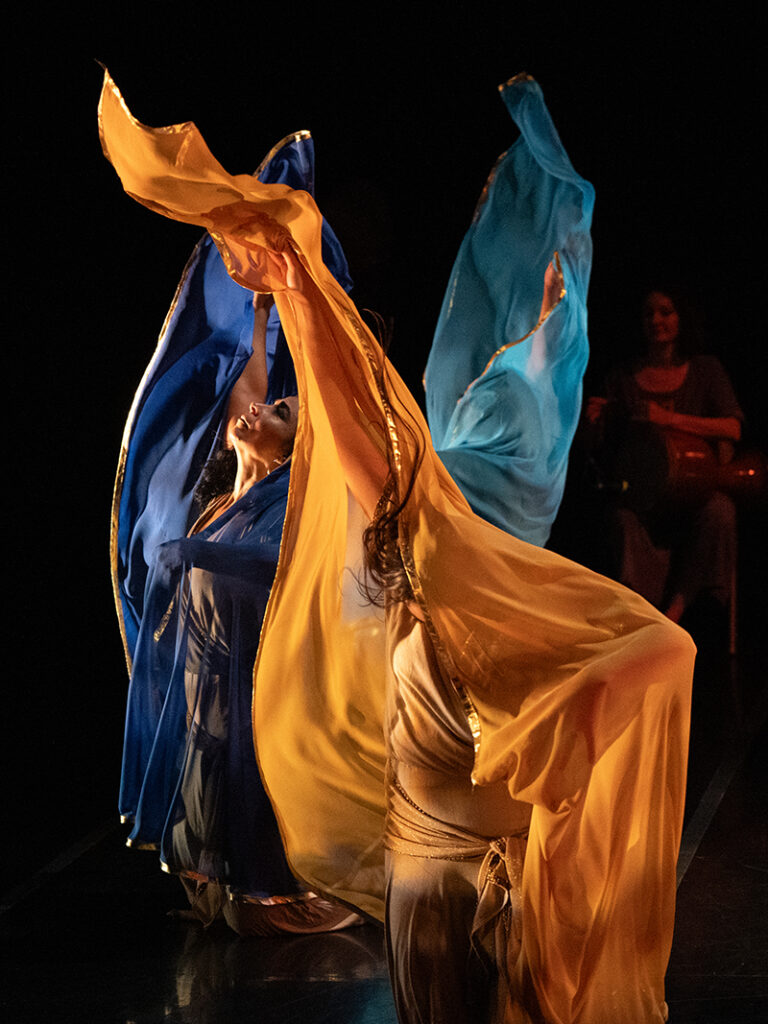
Parya Saberi in I Plant My Hands in the Garden
The first piece The Garden of Mirrors (poem by Ahmed Shamlou) takes place in a studio ringed in windows. The lights are low, and the last of the sunset is seeping onto the hardwood floors. Guests fill the space, standing, seated on pillows, and giving their focus to the semicircle of black boxes which indicate the performance space. Musician Elaheh’s tombak (goblet drum) begins to roll and tap in bright accents, and the “Box Keepers,” (dancers Patti Kjonas, Donna Simon, Janelle Rodriguez, Sabriye Tekbilek, and Mela Amaiya) dressed in black, enter the space. Soloist Parya Saberi takes her place in the center, dressed bright red. Her finger cymbals ping and cluck, as she executes torso isolations and undulations with reverie. At first, her dancing is applauded by the “Box Keepers,” reminiscent of Iranian social dance situations. She visits each keeper in turn. She dances for them, and they each offer her a “gift:” heavy blush, kohl (eyeliner), lipstick, and finally, a bright blonde wig. All are applied “to the max.” Each new “beautification” glares garishly in the lighting, energetically askew to the simple joy that the piece began with. As Saberi continues to dance, undertaking this ascribed identity, her gaze intensifies and the movement becomes more direct and quick. Saberi expertly embodies the rejection of societal expectation as well as the impulse to rise to it. She has shouldered this initial weight too well, so the “Box Keepers” rise, and begin to load her down with pots, pans, aprons, and various homemaking objects. Finally, Saberi’s movement is slowed, and the piece ends with a veil engulfing her body, as if finally extinguishing the last bit of joy brought by her movement. As we applaud, the drums sound behind us. The next garden is waiting.
As we re-enter the lobby in order to pass through the double doors into Garden of Grapes, Garden of Plums (poem by Ahmed Shamlou), we encounter dancers Shahrzad Khorsandi and Aisan Hoss standing side by side, dressed in white and holding a long, brightly colored scarf between them. They stare straight ahead, without acknowledging our presence. They are the gatekeepers of this garden, apparitions come to lead us forward. The doors open, and we enter a black box space where soloist Aliah Najmabadi sits center stage, body folded over her legs, hands outstretched in front of her and bound. It brings to mind the haunting image of protestor Khodanour Lajai’s last moments captured on film. Khorsandi and Hoss untwine the scarves held between them, delineating the invisible barrier between us, a line between the living and the spirit realm. We are drawn further into the fold by the bittersweet and masterful music of musicians Azadeh Farpour (vocals), Ava Nazar (keyboard), Elaheh (tombak), and Clarissa Bitar (oud).
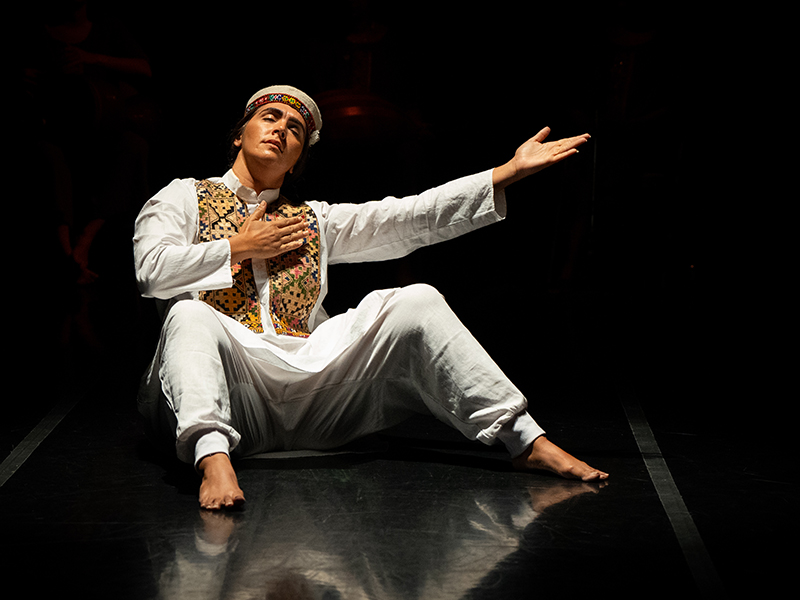
Aliah Najmabadi in Garden of Grapes, Garden of Plums
Najmabadi, embodying Khodanour Lajai, who was murdered by the Islamic Republic in the Zehedan massacre, performs quick steps, joyful gestures and rolling hips, mimicking Lajai’s personal movements rooted in Baluchi dance. My heart ached at the absence of this bright soul, visiting us ever so briefly through Najmabadi’s piece. As Najmabadi’s solo ends, Khorsandi picks up where she left off, her movement capturing all of the vibrancy and gusto of 23 year-old Hadis Najafi, who was murdered during protests in Mehrshahr, Karaj. Khorsandi’s light and lifted foot movements, arms outstretched with abandon, intermingle delicately with an underlying shamelessness and bravery, exemplified by brief moments of audacious poses and rooted movement at center stage. As we watch Khorsandi perform girlish skips and twirls, the audience runs headlong into an unavoidable truth: the people bravely risking and losing their lives in the name of freedom are doing so at the dawn of their lives. It is hard to reconcile that this person, so full of life and possibility, is now gone. As Khorsandi exits, tucking her hair up in a nod to the viral video of Najafi tying her hair back before clashing with Morality Police, Hoss replaces her at center stage. Hoss’ face contorts into a silent scream, left hand miming holding a microphone as her torso leans to one side, head tilting and eyes direct. Hoss performs phrase work based on the gestures of 16 year-old Nika Shakarami, who mysteriously disappeared during a protest and was found dead days later. Hoss cultivates a picture of Shakarami’s youthful singing performances through pointing and leaning. This phrase work develops into hand gestures that grow like flames, then encircle her neck and pull upwards as she stumbles sideways, conjuring a brief but abject image of hanging. Hoss delivers us all the defiance, bravery, and beauty Shakarami has come to represent since her death. As Garden of Grapes, Garden of Plums comes to a close, the three performers stand in stillness and silence at the edge of the stage, allowing us to honor the lives of these three taken far too soon.
The lights fade to black, and when they come up again, four rectangular pools of light are projected onto the floor, containing three dancers (Parya Saberi, Rachel Duff, and Kayla Hummel) in prostration, clad in deep green dresses. Garden of 100 Memories (poem by Fereydoon Moshiri) feels like a window into one’s most private space. Although the movement can be connected to prayer, the dancers also give us a glimpse into their individual private struggle. Their bodies lift, arms reach, and hands ripple at varying intervals, only to fall to the floor once more. Heads move side to side, blowing breath over shoulders as if passing their prayers onto the wind. Hands tap the top of their thighs as they kneel in the light. These ritual movements are bisected by moments of unison, and as the dancers venture into other spaces and realms, they come back to the rectangle and the ritual as a point of connection. The movement contains themes of both restriction/containment as well as comfort/assurance. The eternal return provides a space for the body to arrive in all states of being, while requiring it to perform certain actions as a toll for a moment of deep privacy and reflection.
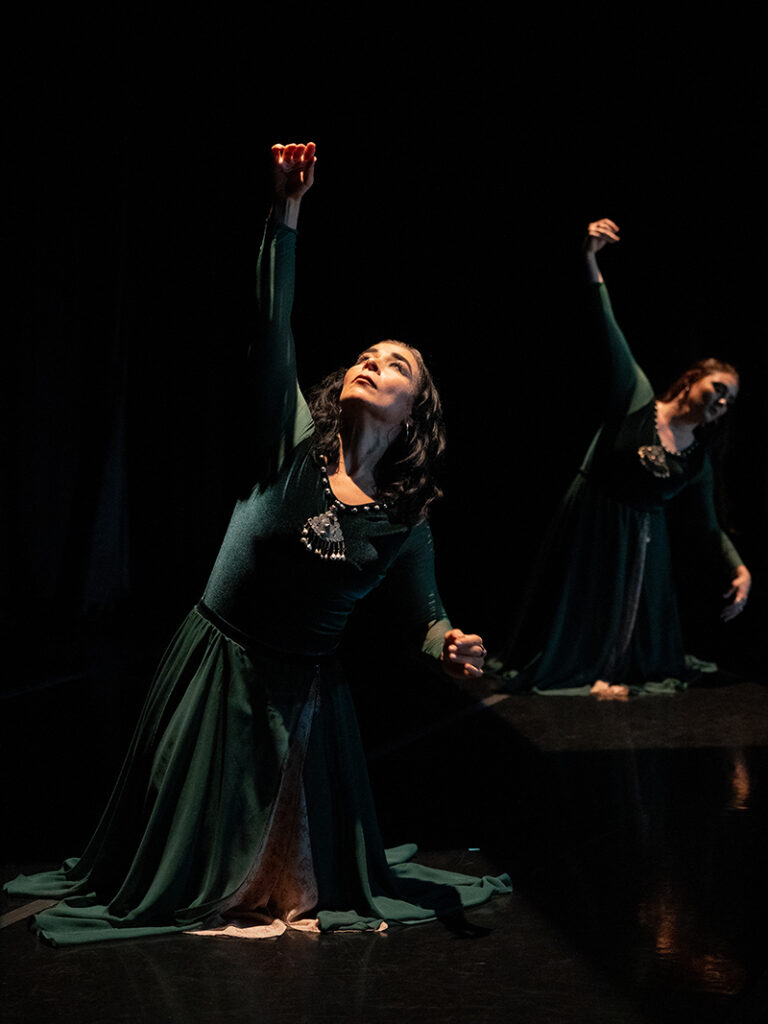
Parya Saberi and Kayla Hummel in Garden of 100 memories
The drums lead us into the next garden, and we travel into another room lined with windows as sounds from the Mission District lilt in from below. The chairs sit at a diagonal angle, facing a white backdrop where musicians Azadeh Farpour, Ava Nazar, Clarissa Bitar, Farin Foroudi, and Elaheh sit lined against it. Moonlight Garden (poem by Simin Behbahani) opens with four dancers (Parya Saberi, Rachel Duff, Kayla Hummel, and Mela Amaiya) performing sharp, staccato movements with outstretched arms, like the hands of a clock. They sway their hair over their shoulders and perform canons of syncopated claps and slaps as they move circularly around one another. Farpour croons the words of Iranian classic Laili Jaan, and the dancers gather together, dancing in tight unison while their bodies remain close. The spirit is one of togetherness, of finding one another in all of life’s tribulations and cycles. It evokes nostalgia: women dancing in living rooms, smiling coyly at one another, and sharing jokes and food free from society’s gaze.
The bittersweet reverie of Moonlight Garden fades, and we get a moment of breath before Farpour anchors us with classical vocals against Bitar’s oud. The audience is rapt as the cloaked figure of Suhaila Salimpour walks towards the stage, and we arrive in the Garden of the Nightingale (poem Hushang Ebtehaj). As Salimpour removes the cover from her hair, it is as if she has passed over a threshold between the public and the private space. It is here that we bear witness to a mother’s mourning. Salimpour’s movements seem to radiate from an unhealed center out of and beyond her extremities. It resonates as the kind of energy only the deepest wounds can mobilize. We are invited to bear witness as she moves through the pain of both memory of the past and reality of the present. She reaches an arm out and pulls towards her center, curls forward as if doubling over in pain, and then slides into movement around the space. Tears slip down my cheeks as Salimpour turns her back to the audience and locks eyes with Bitar. In this moment, we witness them weaving their stories together, movement by moment. It is a convergence of music, dance, culture, history, and energy. Farpour’s vocals drive the journey forward. For a moment, this exchange suspends us between worlds, timelines, and places, until Salimpour melts gently to the floor, lying on her side as her hand covers her face, and we are returned to the present moment.
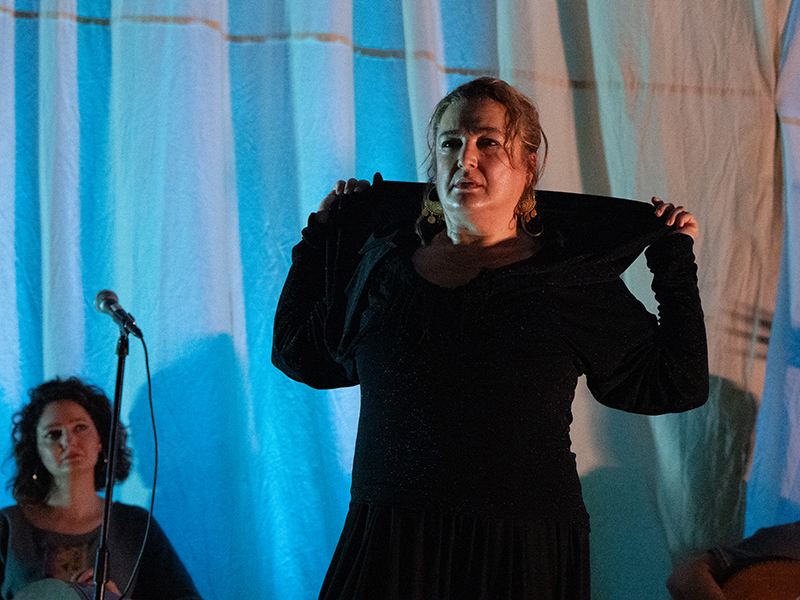
Suhaila Salimpour in Garden of the Nightingale
The familiar drums remind us that it is time to move again, and we file into the last studio space, where a large cube sits in the center, translucent projector screens on all four sides. There is seating on one side of the cube, and a wall of mirrors covered in curtains with one mirror left exposed on the other. The projections include photos from the past year of the Woman, Life, Freedom movement and scenes from the Iranian landscape. It becomes clear that the solo figure of Saberi is in the middle of the cube, kneeling and cloaked in a black, glittering cloth. As I Feel Sorry for the Garden (poem by Forugh Farrokhzad) begins, a soundtrack of Saberi’s mother whispering in prayer plays against a city soundscape and men speaking Farsi. Saberi fights with the veil, pulling it taught, pulling her hair, silently screaming. As Saberi comes free of the veil, she begins to touch the borders of the cube, gliding her fingertips along the fabric. She pauses for a moment when she catches a glimpse of herself in the mirror, her breath shaking as she takes in her reality. One, two, or even three layers may be removed, but there is always another boundary or border to cross. Saberi replaces the veil and resumes her kneeling position, as the audience is led to the final garden.
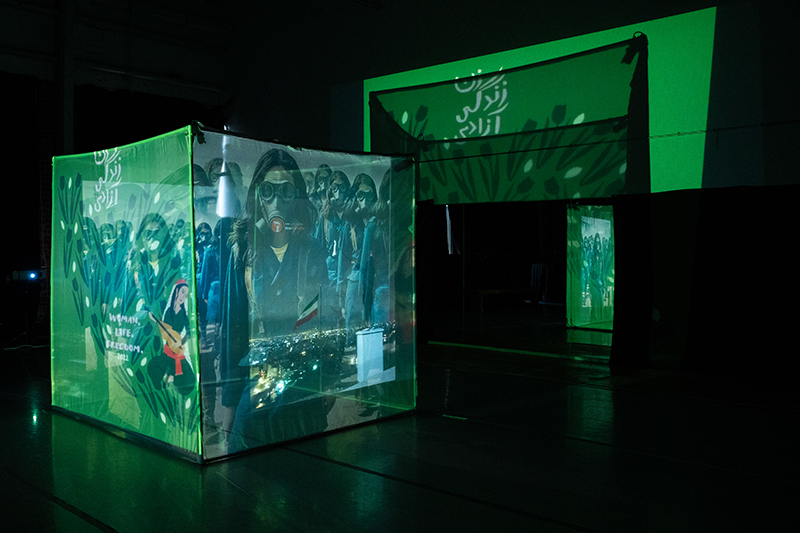
I Feel Sorry for the Garden
We re-enter the black box space to a virtuosic keyboard solo by Ava Nazar. I Plant My Hands in the Garden (poem by Forugh Farrokhzad) begins with rumbling figures under colorful veils, and breaks forth into a spray of hair tossing and flinging with powerful upper body movements. This is a reclamation of joy as Parya Saberi, Rachel Duff, Kayla Hummel, Janelle Rodriguez, and Sabriye Tekbilek sway smoothly around the stage, pausing for articulate hip accents and earthbound bounces of their heels. The music whips up in speed and energy, and the audience is brought onstage, holding hands and dancing as Saberi plays the Daf in the center. This end is fitting, as bodies, both Iranian and otherwise, boldly fill the space and dare to dance, holding space for the expansive and complex truths of the human experience.
Dancing With Hafez rejects hyper traditionalism while remaining true to its Iranian core, which creates a contemporary meeting point for disparate Iranian experiences. Saberi and Salimpour have masterfully woven their personal experiences with cultural practices and objects in a way that invites audiences into their world, regardless of background. However, for the Iranian viewer, Saberi and Salimpour have pulled back the curtain on deep cultural nuances which are often held in silence, and told those truths in the way only the moving body can. I saw my own heartbreak, rage, truth, duality, conflictedness, and pride reflected to me in a way I have not experienced before. In shining light into these depths and corners, Dancing With Hafez becomes much more than a show. It is all the mountains we don’t get to climb in the homeland of our fathers, the funerals, births, and weddings we don’t get to attend because they remain a world and a regime away, all the smells, tastes, and sounds of home that linger in our senses while we try to recreate them from memory. By pulling on the underpinnings of our shared experiences in the diaspora, Saberi and Salimpour have cultivated a gathering place for the displaced, misplaced, distanced, forgotten, and longing to find a point of connection. Thank you, Parya and Suhaila, for inviting us into your home and giving strangers the opportunity to mourn, pray, laugh, and dance together.
Our ancestors are smiling.
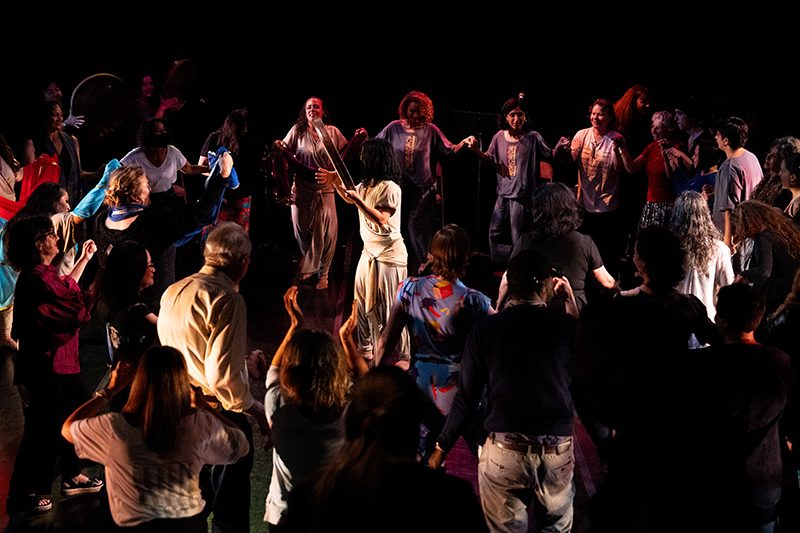
Parya Saberi with audience
~~
